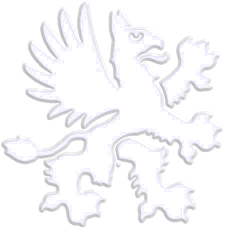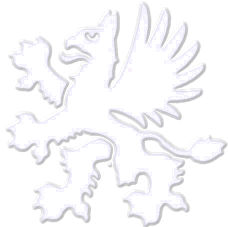

The U-spell
A spelling system for the Genoa's language
compatible with the one officially used
by the Vocabulary of the Ligurian Speeches
The genoese U-spell applies most of the rules of the italian orthography.
A Æ B C Ç D E F G H I J L M N O Œ P Q R S T U V X Y Z
The genoese language consists of 31 phonemes: 8 vowels, 3 semivowels and 20 consonants.
The vowels can be short or long.
The difference between long (free) and short (checked) vowels consists in the the long vowels being prolonged as long as twice the duration of the short ones.
Long vowels are always stressed. Genoese words can be isotonic, that is, they can have several stresses of equal intensity.
There can be opposition between short and long vowels.
The consonants can be single or geminate.
A consonant immediately preceeding a stressed vowel is always single.
Short stressed vowels are only followed by geminate consonants.
The geminate phoneme is indicated by simply doubling the grapheme;
for those geminates indicated by digraphs which cannot be doubled (SC and GN) a diacritic indicating the duration of the preceding vowel will suffice.
The accents
The circumflex accent ( ^ ) indicates that the vowel is long. Long vowels are always stressed.
The acute ( ´ ) and grave ( ` ) accents indicate that a vowel is stressed and short.
A indicates the phoneme /a/
"bàilu" /'bajlu/ (trunk), "dattai" /'dattaj/ (dates, fruit), "câsetta" /ka:setta/ (sock)
Æ indicates the phoneme /ɛ/,
short in front of N: "mænn-a" /'mɛŋŋa/ (marine), "Madænn-a" /ma'dɛŋŋa/ (Madeleine)
otherwise long: "ægua" /'ɛ:gwa/ (water), "tæra" /'tɛ:ra/ (earth), "træ" /'trɛ:/ (three, fem.)
B indicates the phoneme /b/
"barba" /'barba/ (beard - uncle), "ben" /beŋ/ (well)
C is bivalent:
it indicates the phoneme /k/ in front of A Æ O Œ U Y
"carêga" /ka're:ga/ (chair), "cumme ?" /'kumme/ (pardon ?)
or the phoneme /ʧ/ in front of E I J
"ciæu" /'ʧɛ:u/ (bright), "cianŷa" /ʧa'ny:a/ (plain)
CI is a digraph: in front of A Æ O Œ U Y it indicates the phoneme /ʧ/
CH is a digraph: in front of E I it indicates the phoneme /k/: "cichetunn-a" /ʧike'tuŋŋa/ (drunkard)
D indicates the phoneme /d/
E indicates the phoneme /e/,
short ( é ) "gente" /'ʤeŋte/ (people) or long ( ê ) "inderê" /iŋde're:/ (to the back)
È indicates the phoneme /ɛ/ only short: burdèllu" /bur'dɛllu/ (brothel), "sciarbèlla" /ʃar'bɛlla/ (flip-flop)
F indicates the phoneme /f/: "fygassa" /fy'gassa/ (focaccia)
G is bivalent:
it indicates the phoneme /g/ in front of A Æ O Œ U Y "galinn-a" /ga'liŋŋa/ (hen)
or the phoneme /ʤ/ in front of E I J: "figiœa" /fi'ʤø:a/ (child, fem.)
GI is a digraph: in front of A Æ O Œ U Y it indicates the phoneme /ʤ/
GH is a digraph: in front of E I it indicates the phoneme /g/
GN is a digraph, it indicates both the single /ɲ/ and the geminate /ɲɲ/: "zýgnu" /zy'ɲɲu/ (june)
H is an indicator used after C or G (see) or in front of some verb forms or in some exclamations
I is trivalent: it indicates
J indicates:
L indicates the phoneme /l/:
M indicates the phoneme /m/
N is bivalent. It indicates
NN- is a trigraph: it indicates the phoneme /ŋ/ between vowels: "schenn-a" /'skeŋŋa/ (back, anat.),
O indicates the phoneme /ɔ/: "côse ?" /'kɔ:se/ (what ?)
Œ (or Ö ) indicates the phoneme /ø/: "prescinsœa" /preʃiŋ'sø:a/ (sour cream)
P indicates the phoneme /p/
Q always followed by U: it indicates the phoneme /k/ followed by /w/
R indicates the phoneme /r/
S indicates the phoneme /s/ "sinsâe" /siŋ'sa:e/ (mosquitoes)
SC in front of E I J is a digraph: it indicates the phoneme /ʃ/: "scixerbua" /ʃi'ʒɛrbwa/ (whore)
SCC indicates the succession of /ʃ/ and /ʧ/: "scciypòu" /ʃʧy'pɔw/ (exploded)
T indicates the phoneme /t/ : "tyttu" /'tyttu/ (everything)
U is bivalent. It indicates:
V indicates the phoneme /v/
X indicates the phoneme /ʒ/: "adâxu !" /a'da:ʒu/ (easy !)
Y (or Ü) is bivalent:
it indicates the phoneme /y/: "gysti" /'gysti/ (tastes)
it also (rarely) indicates the phoneme /ɥ/: "custipasyin" /kustipa'sɥiŋ/ (constipations)
Z indicates the phoneme /z/: "zeneize" /ze'nejze/ (genoese)